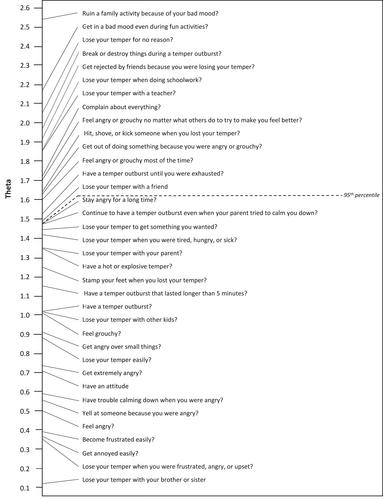Characterizing the spectrum of irritability in preadolescence: Dimensional and pragmatic applications
Abstract
Objectives
Characterize the dimensional spectrum of preadolescent (PA) irritability, a robust transdiagnostic vulnerability marker, using the youth version of the Multidimensional Assessment Profiles Temper Loss (MAPS-TL-Youth) scale including common and with developmentally specific items. Based on this, derive and validate a clinically optimized irritability screener to flag psychopathology risk in preadolescents.
Methods
The normal:abnormal irritability spectrum was modeled using MAPS-TL-Youth data from the Multidimensional Assessment of Preschoolers Study (MAPS) Study PA wave (n = 340) via item response theory. Both cross-cutting core items from the MAPS scales and developmentally specific items were used to generate this dimension. Stepwise logistic regression was then used to optimize MAPS-TL-Youth irritability items in relation to Kiddie Schedule of Affective Disorders and Schizophrenia impairment to generate a clinically optimized irritability screener. Receiver operator characteristic analysis identified the irritability threshold for the screener. For the first time, youth self-report of their own irritability on the MAPS-TL was also modeled via the MAPS-TL-Youth-Self-Report (MAPS-TL-Youth-SR).
Results
Irritability was unidimensional and ranged from mild and common to severe and rare behaviors. Developmentally specific items allowed detection of more severe irritability. Items for the screener were identified in relation to concurrent impairment. These included low frustration tolerance and pathognomonic severe behaviors. The clinically optimized screener demonstrated very good sensitively (87%) and specificity (81%) in regard to concurrent irritability-related DSM disorders. Modeling of the MAPS-TL-Youth-SR yielded similar results.
Conclusion
Characterizing the normal: abnormal spectrum of irritability in preadolescence advances application of Research Domain Criteria methods to this developmental period. This foundational work yielded two developmentally specified tools for irritability characterization in preadolescence: a nuanced dimensional scale to precisely characterize the full normal-abnormal irritability spectrum, and a pragmatic, clinically optimized screener suitable for real world use. Future application in mechanistic and clinical studies will be important for establishing validity and incremental utility.


 求助内容:
求助内容: 应助结果提醒方式:
应助结果提醒方式:


